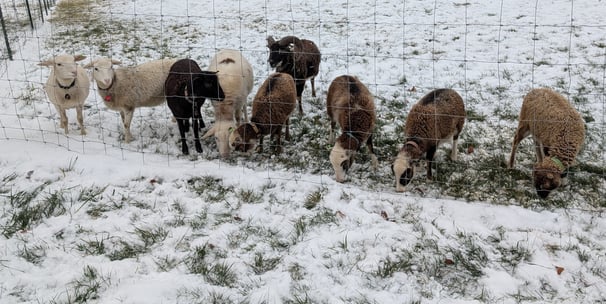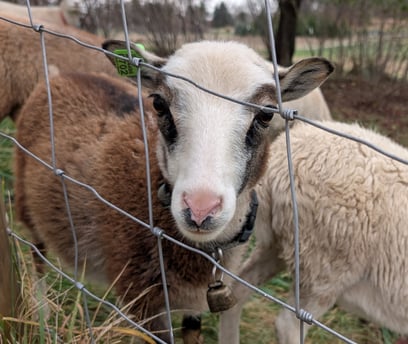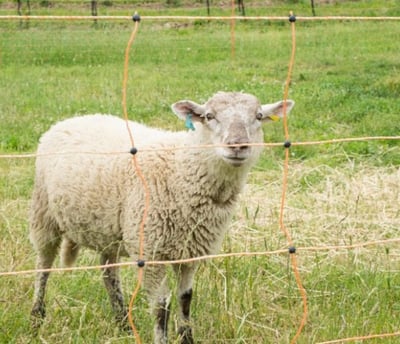Toxic Plants
Ensuring your pastures and surrounding areas are free from toxic plants is a critical aspect of sheep safety. While sheep often avoid poisonous plants if ample good forage is available, curiosity, boredom, or a lack of other options (especially during drought or overgrazing) can lead them to eat things that can cause serious illness or even death (Alabama Cooperative Extension System, n.d.).
Here’s what you need to know about toxic plants for your sheep care guide:


Why Plant Toxicity Matters
Health Risks: Poisonous plants can cause a wide range of issues, from mild digestive upset to severe organ damage (liver, kidneys), neurological problems, birth defects, photosensitization (severe sunburn), and sudden death.
Production Losses: Even non-fatal poisonings can lead to weight loss, reduced milk production, and poor growth in lambs.
Vet Bills: Diagnosing and treating poisoning can be difficult and costly.
How Poisoning Occurs
Poor Pastures: When good grass and browse are scarce, sheep are more likely to sample weeds and other plants they'd normally avoid.
Curiosity: Lambs, in particular, explore by nibbling and may ingest toxic plants.
Hay Contamination: Toxic plants can be accidentally baled into hay. Drying doesn't always destroy toxins, and some plants even become more palatable when dry.
Garden/Yard Clippings: NEVER throw lawn clippings or trimmings from ornamental shrubs and trees into a sheep pasture. Many common garden plants are extremely toxic. This is a very common cause of poisoning, especially with Yew.


Vigilance and good pasture management are your best defenses against plant poisoning in your flock.


General Signs of Poisoning
Symptoms vary widely depending on the plant and the amount eaten, but can include:
Sudden, unexplained death
Staggering, trembling, seizures, or paralysis
Difficulty breathing, rapid/weak pulse
Frothing at the mouth, excessive salivation
Bloating, abdominal pain
Diarrhea or constipation
Depression, weakness, lethargy
Photosensitization (sunburn on non-wooled/light-skinned areas)
Jaundice (yellowing of gums/eyes)
If you suspect plant poisoning, act immediately!
Common Plants Toxic to Sheep (Especially in Michigan & Surrounding Regions)
This list is not exhaustive, and plant prevalence varies. It's crucial to learn to identify plants in your specific area. Consult your local extension office for regional guides.
1. Landscaping & Ornamentals (Often High Risk!)
Yew (Taxus spp.): EXTREMELY TOXIC. Even small amounts are rapidly fatal. A major risk from discarded Christmas wreaths or landscape trimmings.
Rhododendrons & Azaleas (Rhododendron spp.): Very toxic. Cause vomiting, salivation, staggering, and can be fatal. Mountain Laurel is in this family and also toxic.
Japanese Pieris (Pieris japonica): Similar toxicity to Rhododendrons.
Oleander (Nerium oleander): Highly toxic, affects the heart. More common in warmer zones but sometimes grown in pots or protected areas.
Foxglove (Digitalis purpurea): Contains cardiac glycosides; affects the heart.
Lily of the Valley (Convallaria majalis): Contains cardiac glycosides.
Lantana (Lantana camara): Causes photosensitization and liver damage.
Holly (Ilex spp.): Berries and leaves can cause digestive upset.
2. Pasture Weeds & Wild Plants
Bracken Fern (Pteridium aquilinum): Contains thiaminase (destroys Vitamin B1) and a carcinogen. Causes weakness, weight loss, and bleeding over time.
Milkweeds (Asclepias spp.): Contain cardiac glycosides. Common Milkweed is one example.
Nightshades (Solanum spp.): Includes Black Nightshade and Horsenettle. Contain solanine, causing digestive and neurological signs.
Hemlock (Poison & Water Hemlock - Conium & Cicuta spp.): EXTREMELY TOXIC. Affects the nervous system, causing paralysis and rapid death. Water Hemlock (chambered roots) is considered one of North America's most toxic plants. Learn to distinguish them from wild carrot (Queen Anne's Lace).
Pokeweed (Phytolacca americana): Roots are most toxic, but leaves/stems/berries are also poisonous, causing digestive upset.
Jimsonweed (Datura stramonium): Contains tropane alkaloids, causing neurological signs.
Cocklebur (Xanthium spp.): Seedlings and seeds are toxic, affecting the liver.
Buttercups (Ranunculus spp.): Can cause irritation and blistering in the mouth and digestive tract. Usually avoided due to bitter taste.
St. John's Wort (Hypericum perforatum): Causes primary photosensitization.
White Snakeroot (Ageratina altissima): Contains tremetol, can cause "trembles" and can be passed through milk.
3. Trees & Shrubs
Wild Cherry / Chokecherry (Prunus spp.): Wilted leaves are the biggest danger. Stress (frost, drought, broken branches) causes leaves to produce cyanide (prussic acid), which is rapidly fatal (prevents oxygen use).
Red Maple (Acer rubrum): Wilted or dried leaves are highly toxic, causing destruction of red blood cells, leading to anemia, jaundice, and often death.
Oak (Quercus spp.): Acorns and young leaves/buds contain tannins. Eating large amounts can cause severe digestive upset and kidney damage.
Black Locust (Robinia pseudoacacia): Bark, leaves, seeds, and sprouts are toxic.
Black Walnut (Juglans nigra): Primarily an issue for horses (bedding), but ingestion can cause problems.
Prevention: The Best Medicine
Learn Plant ID: Get a good regional field guide or use plant ID apps. Walk your pastures and fence lines regularly. Consult your MSU Extension office for help.
Maintain Healthy Pastures: Good pasture management is key. Fertilize based on soil tests, manage weeds, and use rotational grazing. Healthy, dense forage gives sheep good choices, so they are less likely to eat weeds (UNH Extension, n.d.).
Avoid Overgrazing: Don't force sheep to eat everything down to the dirt.
Fence Off Dangers: Permanently fence off known toxic plant patches or high-risk areas (like ornamental gardens).
Control Weeds: Use mowing or safe (follow withdrawal times!) herbicides to control toxic plant populations. Sometimes hand-pulling is necessary (wear gloves!).
Inspect Hay: Check hay for toxic weeds before feeding. If in doubt, discard it.
NO YARD WASTE: Never feed lawn clippings or ornamental trimmings. The risk is too high.
Provide Minerals & Water: Ensure sheep always have access to appropriate minerals and fresh water, so they aren't driven to eat strange things out of deficiency or thirst.
Emergency Action: Suspected Poisoning
Remove Immediately: Move all sheep away from the suspected pasture or feed source immediately.
Call Your Vet: Contact your veterinarian without delay. Time is critical.
Identify the Plant: If possible, safely collect a sample of the suspected plant (including leaves, stems, flowers/seeds, and roots if possible) in a plastic bag for the vet to identify. Wear gloves.
Provide Supportive Care: Keep the affected sheep calm, quiet, and provide fresh water and safe hay, but only follow specific treatment advice from your vet.
